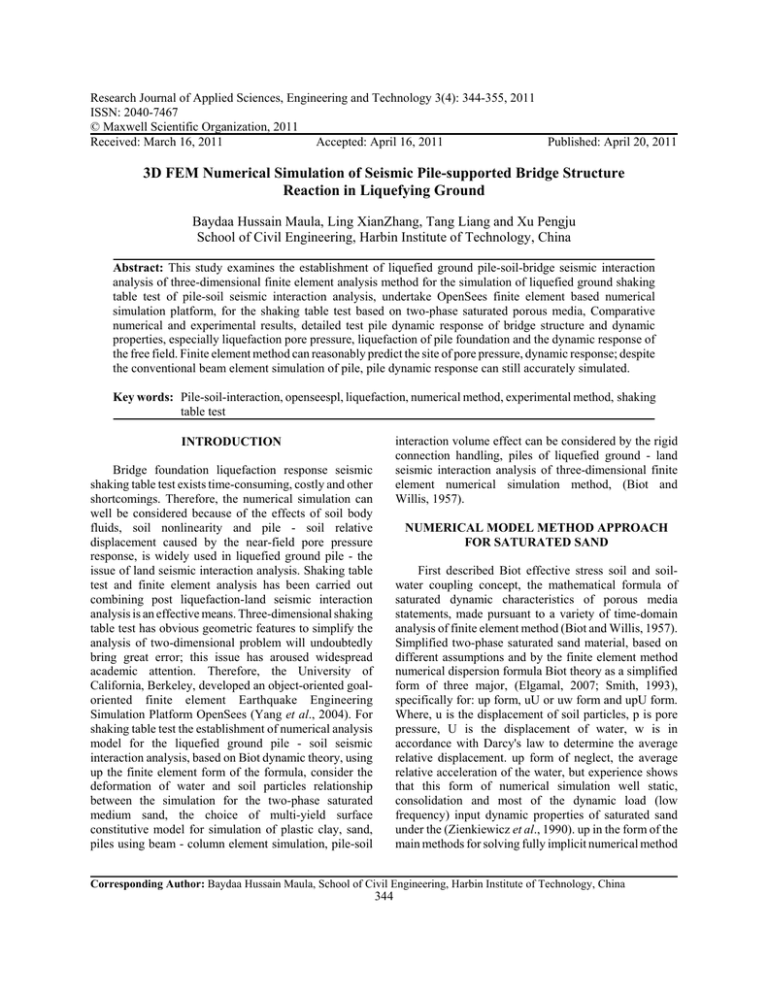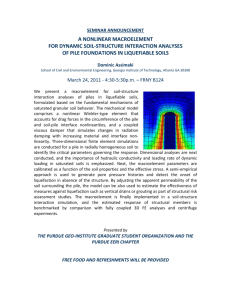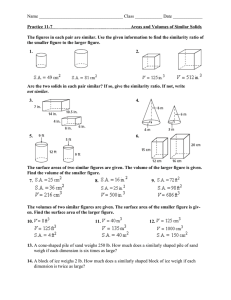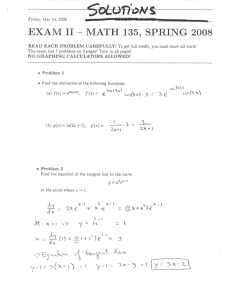Research Journal of Applied Sciences, Engineering and Technology 3(4): 344-355,... ISSN: 2040-7467 © Maxwell Scientific Organization, 2011
advertisement

Research Journal of Applied Sciences, Engineering and Technology 3(4): 344-355, 2011 ISSN: 2040-7467 © Maxwell Scientific Organization, 2011 Received: March 16, 2011 Accepted: April 16, 2011 Published: April 20, 2011 3D FEM Numerical Simulation of Seismic Pile-supported Bridge Structure Reaction in Liquefying Ground Baydaa Hussain Maula, Ling XianZhang, Tang Liang and Xu Pengju School of Civil Engineering, Harbin Institute of Technology, China Abstract: This study examines the establishment of liquefied ground pile-soil-bridge seismic interaction analysis of three-dimensional finite element analysis method for the simulation of liquefied ground shaking table test of pile-soil seismic interaction analysis, undertake OpenSees finite element based numerical simulation platform, for the shaking table test based on two-phase saturated porous media, Comparative numerical and experimental results, detailed test pile dynamic response of bridge structure and dynamic properties, especially liquefaction pore pressure, liquefaction of pile foundation and the dynamic response of the free field. Finite element method can reasonably predict the site of pore pressure, dynamic response; despite the conventional beam element simulation of pile, pile dynamic response can still accurately simulated. Key words: Pile-soil-interaction, openseespl, liquefaction, numerical method, experimental method, shaking table test interaction volume effect can be considered by the rigid connection handling, piles of liquefied ground - land seismic interaction analysis of three-dimensional finite element numerical simulation method, (Biot and Willis, 1957). INTRODUCTION Bridge foundation liquefaction response seismic shaking table test exists time-consuming, costly and other shortcomings. Therefore, the numerical simulation can well be considered because of the effects of soil body fluids, soil nonlinearity and pile - soil relative displacement caused by the near-field pore pressure response, is widely used in liquefied ground pile - the issue of land seismic interaction analysis. Shaking table test and finite element analysis has been carried out combining post liquefaction-land seismic interaction analysis is an effective means. Three-dimensional shaking table test has obvious geometric features to simplify the analysis of two-dimensional problem will undoubtedly bring great error; this issue has aroused widespread academic attention. Therefore, the University of California, Berkeley, developed an object-oriented goaloriented finite element Earthquake Engineering Simulation Platform OpenSees (Yang et al., 2004). For shaking table test the establishment of numerical analysis model for the liquefied ground pile - soil seismic interaction analysis, based on Biot dynamic theory, using up the finite element form of the formula, consider the deformation of water and soil particles relationship between the simulation for the two-phase saturated medium sand, the choice of multi-yield surface constitutive model for simulation of plastic clay, sand, piles using beam - column element simulation, pile-soil NUMERICAL MODEL METHOD APPROACH FOR SATURATED SAND First described Biot effective stress soil and soilwater coupling concept, the mathematical formula of saturated dynamic characteristics of porous media statements, made pursuant to a variety of time-domain analysis of finite element method (Biot and Willis, 1957). Simplified two-phase saturated sand material, based on different assumptions and by the finite element method numerical dispersion formula Biot theory as a simplified form of three major, (Elgamal, 2007; Smith, 1993), specifically for: up form, uU or uw form and upU form. Where, u is the displacement of soil particles, p is pore pressure, U is the displacement of water, w is in accordance with Darcy's law to determine the average relative displacement. up form of neglect, the average relative acceleration of the water, but experience shows that this form of numerical simulation well static, consolidation and most of the dynamic load (low frequency) input dynamic properties of saturated sand under the (Zienkiewicz et al., 1990). up in the form of the main methods for solving fully implicit numerical method Corresponding Author: Baydaa Hussain Maula, School of Civil Engineering, Harbin Institute of Technology, China 344 Res. J. Appl. Sci. Eng. Technol., 3(4): 344-355, 2011 (Parra, 1996), explicit up implicit method (Zienkiewicz et al., 1987) and implicit-implicit alternating method (Cervera et al., 2006). Caught up in the form of soil particles and pore pressure changes, is the simplest form. This form of neglect of pore water and soil differences in particle acceleration, the compressibility of water. This study established in the form of saturated sand using up a finite element numerical model. up theory of forms can refer to the literature (Ahmed, 1994) up forms of basic assumptions are as follows: C C C C C C sand is fully saturated space density of water remains the same the porosity does not change over time of soil particles can not be compressed water compressible and isothermal process water flow velocity gradient is small and can be neglected for all relative to the acceleration of soil water particles can be ignored (for the low frequency range) consider the continuum of soil ( Enter the ball longer than soil porosity and particle large) small strain and neglect rotation did not give the initial strain C C C C (a) Principal stress space (b) Deviatory plane Motion equation of saturated soil: The equation of motion that saturated soil, such as type (1): σ ij , j − ρiii + ρbi = 0 Fig. 1: Conical yield surfaces in principal stress space and deviatory plane (1) Chan on the importance of this research was, for the role of particle acceleration can be neglected. Therefore, the flow of water conservation equation simultaneous equations of motion expressed as Eq. (4): where, Fij - soil total stress ui- Soil particle displacement matrix bi - Unit volume force quality k ρf The total density D of saturated soil is defined as Eq. (2): ρ = nρ f + (1 − n) ρs ρf (ρ − ρ ii + ρ b ) + ii g f i f i i f i i i ,i − np& =0 Kf (4) RESULTS AND DISCUSSION The constitutive model of soil: Test simulation for undrained saturated sand material. The constitutive model of saturated sand with more yield figurines of soil constitutive model simulation (Yang, 2000), shown in Fig. 1. The model is based on more than the initial yield figurines theory (Prevost model theory framework), the Water movement equations; Eq. (3): i i where, Changes in volume strain increment vector Kf Bulk modulus of water K permeability g Acceleration of gravity p pore pressure (2) where, Ds The density of soil particles Df water density n porosity k (ρ + ρ b ) + ii g i ,i − np& =0 Kf (3) 345 Res. J. Appl. Sci. Eng. Technol., 3(4): 344-355, 2011 (a) Shear stress-shear strain response (a) Von Mises multi-surface (b) Effective confinement-shear stress response Fig. 2: Relationship among shear stress, effective confinement and shear strain in constitutive model (b) Hysteretic shear response yield surface to simulate a multi-lag response of sand circulation (Iwan et al., 1967), especially given the liquefaction caused by medium sand, sand compaction cycle cumulative effect of permanent shear strain (Yang et al., 2002), shown in Fig. 2, and the introduction of appropriate loading - unloading simulation flow rule of sand under cyclic loading input coupling effect of partial volume strain (expansion sand contraction and expansion characteristics of the ideal plastic), to reproduce the experimental observation Enter the large sand under cyclic shear loads was the expansion of the trend and cyclic shear stiffness and strength increase (cycle-slip mechanism of flow) phenomenon. Models into a new hardening of criteria, including four: C C Fig. 3: Von Mises multi-surface kinematic plasticity model C To comply with conventions of classical plasticity, elastic deformation is linear and isotropic, are derived from all non-linear and anisotropic plastic deformation The yield functions including hydrostatic pressure along the main line and has a vertex of the cone surface in stress space. The formation of many multifigurines of the same yield surface vertices, the most out of the failure surface; The kinematic hardening rule Defined by the flow rule of sand at different stages of reactions, including contraction phase of the phase transition in plane shear stress state under the action of the phase transition in the plane of the expansion, shear contraction phase until the uninstall process back to the effective confining pressure Finally, before the start of the expansion of ideal plastic shear loads triggered liquefaction stage of the process, this time, even small changes in shear stress can also cause significant permanent strain; the importance of soil parameters need to have a low strain shear modulus of sand and the friction angle, control expansion effect (phase shift angle, contraction and expansion) parameters and yield strain caused by liquefaction parameters Yield by soil clay figurines of multi-model simulation of the structure, the clay treated as non-linear hysteretic materials and has Mise's multi-faceted exercise plastic deformation, shown in Fig. 3. The soil constitutive model for elastoplastic special attention to the lag of the shear characteristics of soil (including permanent deformation). 346 Res. J. Appl. Sci. Eng. Technol., 3(4): 344-355, 2011 Table 1: Parameters for constitutive model of sand Parameters Loose sand 1700 Density (kg/m3) Reference to low-strain shear modulus 5.5×104 G0 (kPa, PT = 80 kPa) Reference bulk modulus 1.5×105 B0 (kPa, PT = 80 kPa) N (°) Peak shear strain 29 0.1 gmax (PT = 80kPa) Reference mean effective confining pressure 80 PT (kPa) 0.5 np Stress-related parameters Initial void ratio 0.85 Medium sand 1900 China medium sand 2000 Dense sand 2100 7.5×104 1.0×105 1.3×105 2.0×105 33 0.1 3.0×105 37 0.1 3.9×105 40 0.1 80 0.5 0.7 80 0.5 0.55 80 0.5 0.45 Table 2: Parameters for constitutive model of medium clay Parameters Soft clay Hard clay 1300 1800 Density (kg/m3) Reference to low-strain shear modulus G0 (kPa, PT = 80 kPa) 1.3×104 6.0×104 Reference bulk modulus B0(kPa, PT = 80 kPa) 6.5×105 3.0×105 c (kPa) Peak shear strain 18 37 gmax (PT = 80 kPa) 0.1 0.1 N (°) 12 15 np Stress-related parameters 0 0 saturated clay under the ground water level 0.3 m, located in a saturated sand layer and the upper part of the boundary between the clay layers. In order to maximize the true definition of the properties of the soil, the use of the complex soil constitutive model to simulate soil characteristics, soil parameters shown in Table 1 and 2. The upper and lower saturated clay layer of clay with 20 nodes hexahedral element simulation, the central saturated sand can be considered by the pore pressure dissipation and redistribution associated with a three-dimensional pore pressure of soil - water fully coupled 20-8 node hexahedral element simulation. Saturated sand treated as liquid-solid two-phase medium, using Biot equations of soil particles and water interaction. Based on the Biot theory of porous media and through the soil - water fully coupled physical processes of the unit. In order to ensure numerical stability, ensure the soil is almost no drainage, the water under the conditions of incompressible. Therefore, 20-8-node hexahedral element is essentially still 20 parameters such as node hexahedral elements, 20 nodes that solid, liquid 8 that the number of nodes, specifically for the 8 corner nodes of each node has four freedoms degrees, one degree of freedom that the pore pressure degrees of freedom (p), another three said that the displacement of soil particles of the three degrees of freedom (u), only the soil particles on the other nodes of the three displacement degrees of freedom, (Fig. 5). Using 3×3 Gauss-Legendre (Gauss-Legendre) numerical integration method for solving solid phase correlation matrix, was using 2×2 Gauss - Legendre (GaussLegendre) numerical integration method for solving Fig. 4: Finite element model of pile-soil interaction Model, the plastic only in partial stress-strain response. Stress - strain response as a linear elastic response, with partial weight has nothing to do, however, enter the monotonous or cyclic loading, the shear properties of soil are not close relations with the confining pressure. Based on multi-yield surface (nested surfaces) concept, based on the famous Provost rule has been associated flow rule of plasticity, the corresponding expression. Model, the nonlinear shear stress-strain curves using two material constants skeleton-the low strain shear modulus and ultimate shear strength defined by the hyperbolic relationship. Finite element numerical model for seismic response of bridge piles: Shaking table tests have been completed for the establishment of three-dimensional seismic response of bridge pile foundation finite element analysis model, under which to carry out appropriate research. To reduce the calculation, the use of shaking table test geometric symmetry of the body, along with the vibration direction parallel to the axis and through the pile of earth to build half of the idealized symmetric domain analysis model, Finite element mesh of long 2 m, width 1.5 m, high-1.9 m, the three layers shown in Fig. 4, in which the upper 0.3 m thick yellow clay layer, magenta thick saturated sand in central 1.2 m, 0.4 m lower red thick 347 Res. J. Appl. Sci. Eng. Technol., 3(4): 344-355, 2011 Table 3: Physical properties of test pile I (m4) Material E (×103 MPa) RC 8.24 4.91×10-6 IXX (m4) 9.82×10-5 15 8 density (kg/m3) 2350 14 13 5 19 6 20 18 17 3 11 4 12 1 10 9 Compressive strength (Mpa) 5.5 of physical processes. In order to test the correctness of the numerical model, finite element model is assumed to be rigid base, direct input measured the vibration table vibration table acceleration time history records. Reinforced concrete pile length 2.52 m, above the surface long 0.82 m, pile diameter 0.1 m, (Table 3). Pile into a series of simulated beam theory based on linear elastic beam-column element. In order to test the correctness of the numerical model, finite element model is assumed to be rigid base; direct input measured the vibration table vibration table acceleration time history records. For shaking table test, based on the Open Sees simulation platform, using the modeling approach to establish liquefied ground pile-soil-bridge seismic interaction of three-dimensional finite element numerical model, direct input test conditions in the actual numerical model as a base incentive, by comparing the test and calculated pile and soil liquefaction numerical model of dynamic response test to verify the numerical model to establish the accuracy and reliability. Earthquake input conditions were: compression 0.15 g El Centro wave (event A) and 0.15 g El Centro wave (event B). Figure 6 and 7 are given events A, B enter the far-field soil (from the pile 60 cm). A input events, the test value and estimated values showed that the sand layer acceleration gradually decreases from bottom to top, to have weakened the role of input ground motion, peak acceleration is far bottom soil pile area did not change significantly, but at the surface Acceleration has been enlarged, soil test value acceleration time history is almost consistent with the numerical value, almost the same magnitude. Event B input, the bottom layer acceleration gradually increased, and with the sand hole pressure is increased, the numerical value is slightly larger than the experimental value taken by shaking table experiment; relative event A, the soil in event B greater acceleration response may be developed as result of soil liquefaction. Sand pore water pressure in the simulation for the liquefaction of pile - soil interaction analysis is essential. Therefore, it is necessary to sand pore pressure based on test reactions in numerical models of reliability evaluation. Sand pile zone taking into account the recent pile may be significantly affected, especially selected pore pressure response to far-field sand liquefaction as a space power on characteristics of the object of verification accuracy event A and B input, the far-field sand pore pressure and pore pressure ratio time history test numerical and experimental, respectively, shown in Fig. 8 and 9; soil pore water pressure in the two test, 7 16 Shear modulus (MPa) 2.9×103 2 (a) Element DOF number (b) Distribution of element node DOF Fig. 5: Solid-fluid coupled 20-8 node brick element water-related matrix. Reinforced concrete pile length 2.52 m, 0.82 m long above the surface, with diameter of 0.1 m, density 2350 kg/m3, elastic modulus 8.24 103 MPa, flexural rigidity 40.5 kN.m2. Numerical model, a centralized top-quality point applied to the simulation of the upper part of the bridge pile structure (test the quality of the block). Pile into a series of simulated beam theory based on linear elastic beam-column element, the definition of the pile section properties. The beam element can not simulate the effect of the pile geometry, given the geometry of the pile on the pile-soil interaction system significantly affected within the pile of soil is dug out of the node of post node and the link between the soil pile diameter effects into account. This rigid connection element simulation of pile-soil interaction. Rigid Link order to achieve the use of OpenSees pile-soil interaction 348 Res. J. Appl. Sci. Eng. Technol., 3(4): 344-355, 2011 Fig. 6: Recorded and computed acceleration time histories of soil far away from pile under event A Time (s) 349 Res. J. Appl. Sci. Eng. Technol., 3(4): 344-355, 2011 Fig. 7: Recorded and computed acceleration time histories of soil far away from pile under event B Fig. 8: Recorded and computed pore pressure and pore pressure ratio time histories of soil at different depths under event A Time (s) Time (s) 350 Res. J. Appl. Sci. Eng. Technol., 3(4): 344-355, 2011 Fig. 9: Recorded and computed pore pressure and pore pressure ratio time histories of soil at different depths under event B Fig. 10: Recorded and computed of pile bending moment under event A overall trend of more well, showing decreased after increasing trend, decreasing from bottom to top pore pressure, pore pressure ratio increases; earlier than in the small pore pressure is only a small amount of vibration input accumulation, the pore pressure ratio increase quickly, when the peak acceleration time of rapid growth in the vicinity of the pore pressure ratio, and then pore pressure relatively slow growth; in event A maximum of about 5s, but in event B are 15-17s maximum and decreases with depth, pore pressure has extended peak time trend, the numerical values in good agreement with the experimental values are expressed as pore pressure increased rapidly, reaching peak foramen slow dissipation of pressure, but slightly in experimental teat larger than the numerical pore pressure test values especially in depth 0.4 m for event A and in event B which may have the following main reasons: C C 351 Test the water in the observed surface cracks and the walls of the box along the exhaust, causing the pore pressure under the same experimental conditions, partial small, while the numerical simulation of sand will be treated as un drained conditions, therefore value is slightly larger Test the upper clay layer of the foundation as part of the water absorption of the lower part of sand, Res. J. Appl. Sci. Eng. Technol., 3(4): 344-355, 2011 Fig. 11: Recorded and computed of pile bending moment under event B causing sand drainage and pore pressure decreases. Experimental and numerical simulation results show that pore water pressure in event A is smaller than event B. the corresponding value under the event A, this is because the prototype wave caused by a longer duration is more likely caused by the earthquake duration longer the destruction of sand in the pile the most direct expression. Experimental test and numerical simulation results show that three-dimensional numerical simulation method can correctly predict the dynamic response of soil under earthquake characteristics, including acceleration and pore pressure, and its variation is maintained well to consistency. In event A, the peak pile bending moment numerical and experimental values with good peak pile bending moment is slightly smaller than the experimental value of the peak pile bending moment. In event B, the peak moment of the pile in the two tests results match well, well reflects the pile - Characteristics of earthquake interactions. In events A, B, the peak pile bending test for the two tests values decreased after increasing, which was mainly due to the boundary between layers of soil stiffness mutation. However, there are some differences on the moment values, the two test values are less for depth 1.25 m than in depth 0.5 m of the pile test value. Event B show peak pile bending moment conditions than Dissuasion the results for seismic response characteristics of pile: Events A, B, the pile acceleration time history shown in Fig. 10 and 11; The peak bending moment along the experimental and numerical depth distribution shown in Fig. 12 and 13, respectively. By comparing the acceleration time history of pile, the peak pile bending moment in the two tests distribution along the depth comparison are in good agreement in events A, B at different depths of pile tests, only experimental are slightly smaller than the value of the numerical, where curves shape are very similar (Fig. 10 and 11). Event A, the peak pile bending moment numerical and experimental values with good peak pile bending moment but numerical value are slightly smaller than the experimental. In event B, the peak moment of the pile for the two results match well, well reflects the pile Characteristics of earthquake interactions (Fig. 12 and 13). Events A, B, show that the peak pile bending test for the test values decreased after increasing in the 352 Res. J. Appl. Sci. Eng. Technol., 3(4): 344-355, 2011 Fig. 12: Recorded and computed acceleration time histories of pile under event A Time (s) 353 Res. J. Appl. Sci. Eng. Technol., 3(4): 344-355, 2011 Fig. 13: Recorded and computed acceleration time histories of pile under event B the two., the specific performance of pile in sand layer is in the bottom, peak moments occur gradually increasing trend, starting near the bottom boundary layer the peak pile bending moment becomes smaller, the lower part of this response mainly due to pile soil control, but also by the upper part of the upper pile inertia force and the pile weight - the dual role of effects due to soil movement; with increasing liquefaction, pile bending moment will be maximum value in the vicinity of the boundary between layers, on the other hand shows with the development of liquefaction, the upper and lower differences in soil shear strength gradually increased, the boundary between soil pile bending moment generated mutations to soil Pile bending moment occurs near the boundary between mutations in the most obvious. In event B, peak pile bending moment conditions than the corresponding value under the input A are large, this is because the prototype wave caused by a longer duration is more likely caused by the earthquake duration longer the destruction of sand in the pile the most direct expression as shown in Fig. 14 and 15. Fig. 14: Profiles of recorded and computed peak bending moment for pile under event A CONCLUSION Biot dynamic coupling theory and the effective stress principle, using up the finite element equations of the form of realization, taking proper account of the pore pressure and soil skeleton relationship between the deformation will be modeled as a two-phase saturated medium sand, into the simulation of saturated sands under cyclic loading dynamic characteristics of liquefaction, liquefied clay dilatancy characteristics and dynamic swelling properties of the multi-yield surface constitutive model, based on the European pile pull- Bernoulli beam theory of linear elastic beam-column element simulation, pile- can be considered to earthquake interactions with rigid unit volume effect treatment, under controlled conditions to establish liquefaction pile-three-dimensional land seismic interaction finite element analysis model. Fig. 15: Profiles of recorded and computed peak bending moment for pile under event bottom, and the boundary layer at the moment in a mutation, which was mainly due to the boundary between layers of soil stiffness mutation. However, there are some differences on the moment values, the numerical values are less than the experimental test value and in the boundary layer shows the maximum difference between 354 Res. J. Appl. Sci. Eng. Technol., 3(4): 344-355, 2011 Cervera, M., J. Oliver and R. Faria, 2006. Seismic evaluation of concrete dams via continuum damage models. Earthq. Eng. Struct. D., 24(9): 1225-1245. Elgamal, A., 2007. Nonlinear modeling of large-scale ground-foundation-structure seismic response. J. Earthq. Technol., 44(2): 325-339. Iwan, W.D., 1967. On a class of models for the yielding behavior of continuous and composite systems. J. Appl. Mech., 34: 612-617. Parra, E., 1996. Numerical modeling of liquefaction and lateral ground deformation including cyclic mobility and dilation response in soil systems. Ph.D. Dissertation, Rensselaer Polytechnic Institute, pp: 85-101. Smith, I.M., 1993. Overview of nmerical predictions in the VELACS project. Proceedings of the Verifications of Numerical Predictions for the Analysis of soil Liquefaction, 2: 1321-1338. Yang, Z., 2000. Numerical modeling of earthquake site response including dilation and liquefaction. Ph.D. Dissertation, Depatment of Civil Engineering and Engineering Mechanics,Columbia University, New York, NY, pp: 47-59. Yang, Z. and A. Elgamal, 2002. Influence of permeability on liquefaction-induced shear deformation. J. Eng. Mech., 128(7): 720-729. Yang, Z., J. Lu and A. Elgamal, 2004. A web-based platform for computer simulation of seismic ground response. Adv. Eng. Sofrware, 35(5): 249-259. Zienkiewicz, O.C., D.K. Paul and A.H.C. Chan, 1987. Numerical solution for the total response of saturated porous media leading to liquefaction and subsequent consolidation. Numeta 87 Conference, Swansea, pp: 6-10. Zienkiewicz, O.C., A.H.C. Chan and M. Pastor, 1990. Static and dynamic behavior of soils: A Rational approach to quantitative solutions: I. fully saturated problems. P. Roy. Soc. Lond., A, Math., 429: 285-309. By shaking table tests to verify and assess the test pile liquefied ground under controlled conditions - land seismic interaction analysis model and calculation method of three-dimensional accuracy and precision. numerical calculation, for such complex issues, including the pile soil contact nonlinear, the process of soil liquefaction and the drastic change bit and the large deformation of soil box binding effect of such boundary conditions simultaneously, we need to simulate the situation is more complicated. However, a reasonable calculation of the selected parameters, the numerical method can predict the different types of sand pile bridge site and the dynamic characteristics of the finite element method shows high reliability, can better handle Soil strongly nonlinear, nonlinear pile-soil contact and the computational domain boundary conditions and other advantages ACKNOWLEDGMENT The research projects were funded by Major Research Plan of National Natural Science Foundation of China (No. 90815009), National Natural Science Foundation of China (No. 50378031 and 50178027) and Western Transport Construction Technology Projects (No. 2009318000100) and was implemented in State Key Laboratory for Disaster Reduction in Civil Engineering in China. These supporters are gratefully acknowledged. Also the writers would like to thank the laboratory test clerks for their vigorous support. REFERENCES Ahmed, R.M., 1994. Numerical analysis of seismically induced deformations in saturated granular soil strata. Ph.D. Dissertation, Rensselaer Polytechnic Institute, pp: 11-32. Biot, M.A. and D.G. Willis, 1957. The elastic coefficiects of the theory of consolidation. J. Appl. Mech., 1(24): 594-601. 355





